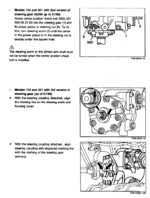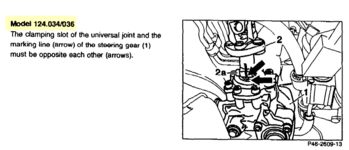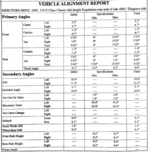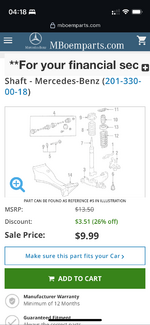My daily driver was badly pulling to one side, causing sever edge wear for the front tires. Those two front tires are barely 18 months old.
I did some toe adjustments to reduce the pull but I know the camber on the right side could be quite off. Depending on the grade of the road, the car could stay straight for pull to the right side.
After replacing a flat rear tire which was quite worn and seeing also edge wear on the rear tire, I knew I need to have the alignment done professionally.
The key word is "professionally". Most the alignment shops and technicians are not properly trained. Have the car aligned in a shop does not mean it is done professionally. This is how the saga started.
Without revealing the name of the shop, here is how the story started. They first put my car up and slapped the sensors (reflectors) on all four tires. Looking from outside, I wondered how could the alignment be correct if the reflectors were not centered to the wheels. Could the alignment software (WinAlign) compensate for the centering error the reflectors, however large? The answer is NO unless the centering error is small enough.
Next thing I noticed was the technician was huffing and puffing to turn my tie-rods. I knew immediately that the guy did not release the 13 mm bolts on the tie-rods. I asked if I could go in to show them something. I was allowed. This was quite surprising because most shops would keep customers out.
I pointed out the 13 mm bolts and told the guy he needed two wrenches to loosen it. After that, he could adjust the toe much easier but the tie-rod was badly scarred by his vise grip. Then he moved to the other side (right side first). He did not loosen the 13 mm bolt again. I had to remind him again.
Finally, he got the toe right but the camber angle could not be adjusted, showing 0 degree camber. I showed him the offset bolts but the camber angle stayed the same after fairly large turn on the bolt. I told the guy that's enough, figuring that I might have to replace the offset bolts before real alignment could be done.
The car still pulled to the right side, not any better.
Two days later, after ordering four Lemforder offset bolts from FCP, I wanted to investigate why the camber angle won't change.
I got under the car and loosened the two offset bolts holding the lower control arm. The front one mainly change the camber while the rear one could also change the toe. I pushed the lower control arm as far out as possible to get the maximum negative camber I can get. I could confirm that the offset bolts are fine. The new order from FCP will be spare parts.
After that, the car was way off. The steering wheel was off and the car pulled to the right side worse than before. I am not surprised because the random camber adjustment I did.
I took the car back to the shop and asked them to check the alignment again and they would do it one more time without charges.
This time, the main alignment technician of the shop took over. He carefully put the reflectors on and checked the centering. After that, he scanned a bar code on the door and the software (WinAlign) found the car and showed pictures of where to loosen to do the alignment. I was allowed inside and under the car again. The main technician was really nice and we discussed fully for every step. He told me he just did a G-wagon a few days before.
Anyway, we first got the rear toe right. No camber adjustment for the rear tires.
We were able to adjust the camber for the front but with the offset bolt at its most outward position on the right and most inward position for the left, both camber angles are at -0.9 degree, 0.1 off the allowable range. I am happy enough. The camber range is from -0.3 to -0.8 degrees.
One interesting thing is that the software can only handle 2 degree toe adjustment. If the the toe is off more than two degrees, for example, 4.6 degrees, it would should show as 0.6 degree off. The technician told me that he has to repeat the toe adjustment by rolling the car backward and forward again and restart the software to do the alignment. The software gave out a warning sound when the toe is more than 2 degrees off, which happened in the first alignment attempt.
In the second attempt, no warning. After the software found the car, it showed that a presser bar should be installed for alignment. They don't have it so it was skipped.
Finally, we got the toe right and the camber stayed at -0.9 degree both sides. The rear showed different toe values so they were re-aligned.
Took the car out for a ride. It is finally straight. I will need to replace both front tires soon.
In conclusion, most technicians do not know how to do alignment adjustments, in particular for Mercedes. After I showed him how to do it, the technician told me that he liked the Mercedes design. I assume that he rarely sees an MB. The presser-bar, required by MB, is really not needed to get the alignment right.
All my five W124s are all now straight. If I were not allowed to go inside the shop, the job probably would not have been done with this particular shop. I am pretty sure the dealer can do it right for a cool $300. My front door neighbor just got a quote of $3000 for his BMW 528i to fix a coolant leak, tiny drop on the garage floor and topping up every few month. I could buy a very nice W124 with $3000.
jftu105
I did some toe adjustments to reduce the pull but I know the camber on the right side could be quite off. Depending on the grade of the road, the car could stay straight for pull to the right side.
After replacing a flat rear tire which was quite worn and seeing also edge wear on the rear tire, I knew I need to have the alignment done professionally.
The key word is "professionally". Most the alignment shops and technicians are not properly trained. Have the car aligned in a shop does not mean it is done professionally. This is how the saga started.
Without revealing the name of the shop, here is how the story started. They first put my car up and slapped the sensors (reflectors) on all four tires. Looking from outside, I wondered how could the alignment be correct if the reflectors were not centered to the wheels. Could the alignment software (WinAlign) compensate for the centering error the reflectors, however large? The answer is NO unless the centering error is small enough.
Next thing I noticed was the technician was huffing and puffing to turn my tie-rods. I knew immediately that the guy did not release the 13 mm bolts on the tie-rods. I asked if I could go in to show them something. I was allowed. This was quite surprising because most shops would keep customers out.
I pointed out the 13 mm bolts and told the guy he needed two wrenches to loosen it. After that, he could adjust the toe much easier but the tie-rod was badly scarred by his vise grip. Then he moved to the other side (right side first). He did not loosen the 13 mm bolt again. I had to remind him again.
Finally, he got the toe right but the camber angle could not be adjusted, showing 0 degree camber. I showed him the offset bolts but the camber angle stayed the same after fairly large turn on the bolt. I told the guy that's enough, figuring that I might have to replace the offset bolts before real alignment could be done.
The car still pulled to the right side, not any better.
Two days later, after ordering four Lemforder offset bolts from FCP, I wanted to investigate why the camber angle won't change.
I got under the car and loosened the two offset bolts holding the lower control arm. The front one mainly change the camber while the rear one could also change the toe. I pushed the lower control arm as far out as possible to get the maximum negative camber I can get. I could confirm that the offset bolts are fine. The new order from FCP will be spare parts.
After that, the car was way off. The steering wheel was off and the car pulled to the right side worse than before. I am not surprised because the random camber adjustment I did.
I took the car back to the shop and asked them to check the alignment again and they would do it one more time without charges.
This time, the main alignment technician of the shop took over. He carefully put the reflectors on and checked the centering. After that, he scanned a bar code on the door and the software (WinAlign) found the car and showed pictures of where to loosen to do the alignment. I was allowed inside and under the car again. The main technician was really nice and we discussed fully for every step. He told me he just did a G-wagon a few days before.
Anyway, we first got the rear toe right. No camber adjustment for the rear tires.
We were able to adjust the camber for the front but with the offset bolt at its most outward position on the right and most inward position for the left, both camber angles are at -0.9 degree, 0.1 off the allowable range. I am happy enough. The camber range is from -0.3 to -0.8 degrees.
One interesting thing is that the software can only handle 2 degree toe adjustment. If the the toe is off more than two degrees, for example, 4.6 degrees, it would should show as 0.6 degree off. The technician told me that he has to repeat the toe adjustment by rolling the car backward and forward again and restart the software to do the alignment. The software gave out a warning sound when the toe is more than 2 degrees off, which happened in the first alignment attempt.
In the second attempt, no warning. After the software found the car, it showed that a presser bar should be installed for alignment. They don't have it so it was skipped.
Finally, we got the toe right and the camber stayed at -0.9 degree both sides. The rear showed different toe values so they were re-aligned.
Took the car out for a ride. It is finally straight. I will need to replace both front tires soon.
In conclusion, most technicians do not know how to do alignment adjustments, in particular for Mercedes. After I showed him how to do it, the technician told me that he liked the Mercedes design. I assume that he rarely sees an MB. The presser-bar, required by MB, is really not needed to get the alignment right.
All my five W124s are all now straight. If I were not allowed to go inside the shop, the job probably would not have been done with this particular shop. I am pretty sure the dealer can do it right for a cool $300. My front door neighbor just got a quote of $3000 for his BMW 528i to fix a coolant leak, tiny drop on the garage floor and topping up every few month. I could buy a very nice W124 with $3000.
jftu105
Last edited:









 It was nice while it lasted.
It was nice while it lasted.
